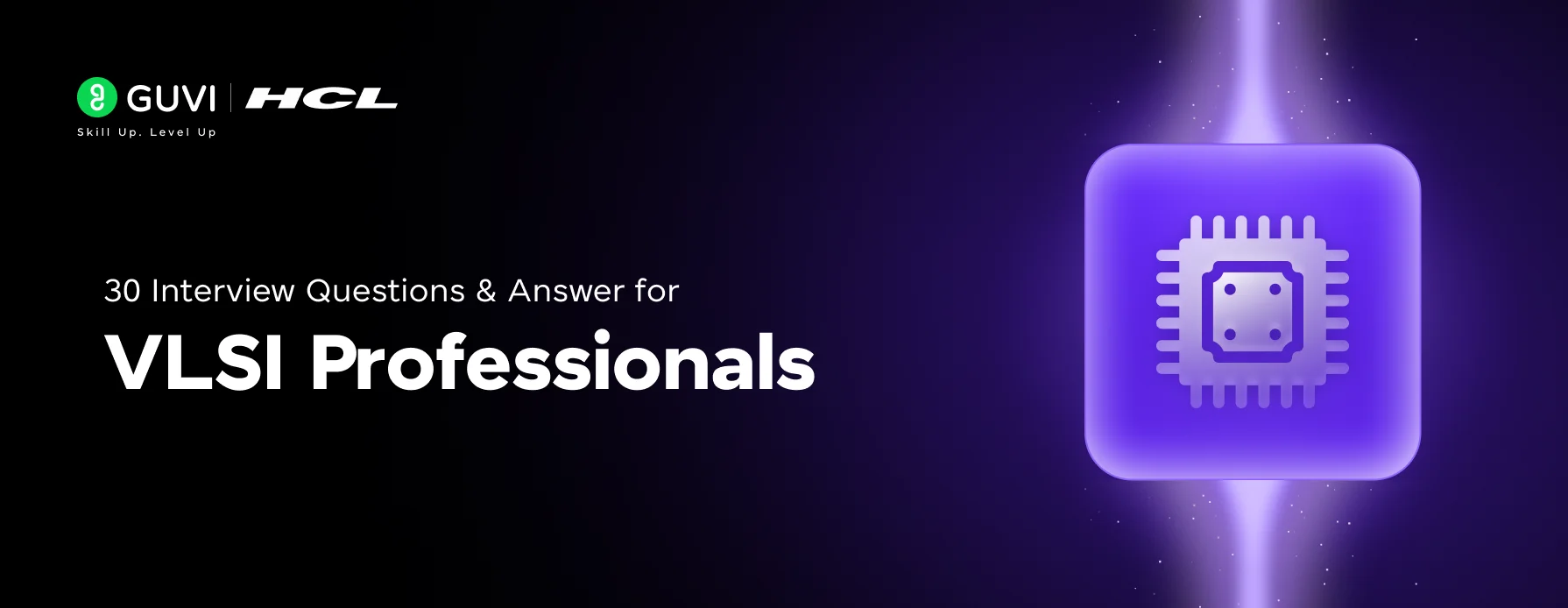
30 VLSI Interview Questions and Answers for Professionals
Jun 25, 2025 5 Min Read 10717 Views
(Last Updated)
Are you preparing for VLSI interview questions and answers, and have no clue what the interviewers will ask you? Worry not, even if you’re a fresher stepping into the world of chip design, an intermediate-level engineer refining your expertise, or an experienced professional tackling complex VLSI challenges, a well-structured interview preparation strategy is essential.
VLSI (Very Large Scale Integration) is the foundation of modern semiconductor technology, driving innovations in processors, memory chips, and advanced SoCs (System-on-Chip). Interviews in this field test your understanding of digital design, CMOS fundamentals, timing analysis, coding (Verilog/VHDL), and real-world industry challenges.
This article compiles 30 commonly asked VLSI interview questions, categorized into Fresher, Intermediate, and Advanced levels, to help you strengthen your fundamentals, improve problem-solving skills, and confidently tackle technical discussions. Without further ado, let us get started!
Table of contents
- VLSI Interview Questions and Answers: Fresher-Level
- What is VLSI, and why is it important?
- What is the difference between ASIC and FPGA?
- What are the advantages of CMOS technology?
- What is the difference between combinational and sequential circuits?
- What are the setup time and hold time in flip-flops?
- What are the different logic families used in VLSI?
- Write a simple Verilog code for a 2:1 multiplexer.
- What is the difference between static and dynamic power dissipation?
- What is clock skew, and how does it impact circuit performance?
- What is the difference between synchronous and asynchronous circuits?
- VLSI Interview Questions and Answers: Intermediate-Level
- What is metastability in flip-flops, and how do you prevent it?
- Explain the difference between SRAM and DRAM.
- What is the role of the FinFET transistor in modern VLSI?
- What are setup and hold time violations?
- What is Design for Testability (DFT), and why is it important?
- What is the difference between full-custom and semi-custom ASIC design?
- What is hold time fixing, and how is it implemented?
- What is IR Drop in VLSI, and how does it impact performance?
- What is the difference between STA and PNR in VLSI design?
- Explain the concept of Dynamic Voltage and Frequency Scaling (DVFS).
- VLSI Interview Questions and Answers: Advanced-Level
- What is crosstalk in VLSI, and how is it mitigated?
- What is latch-up in CMOS circuits, and how do you prevent it?
- What is the difference between Hard IP and Soft IP in VLSI?
- Explain the concept of On-Chip Variation (OCV).
- How is power-aware testing performed in VLSI?
- What are multiple clock domain (MCD) designs, and what challenges do they present?
- What is Electromigration (EM) in VLSI interconnects?
- What are the challenges in designing sub-7nm VLSI nodes?
- Explain Dynamic IR Drop and how it affects chip performance.
- What is Dark Silicon and its implications in VLSI?
- Conclusion
VLSI Interview Questions and Answers: Fresher-Level
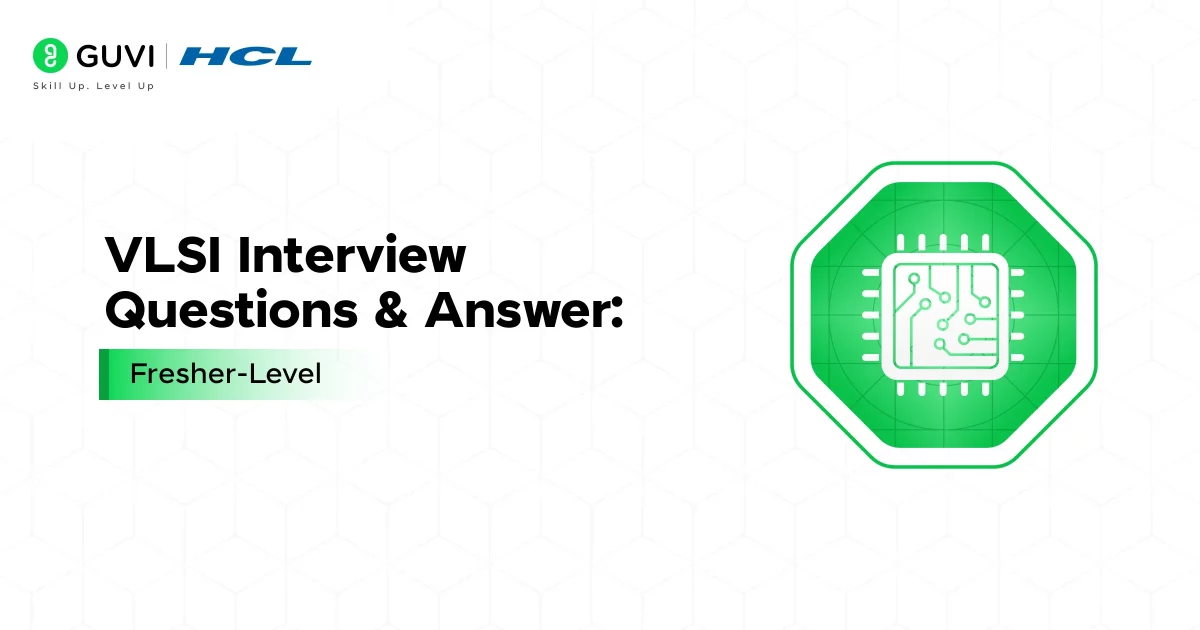
If you’re preparing for a VLSI (Very Large Scale Integration) interview, it’s essential to be well-versed in fundamental concepts. This section provides 10 commonly asked VLSI interview questions and answers for freshers!
1. What is VLSI, and why is it important?
VLSI (Very Large Scale Integration) refers to the process of integrating millions (or even billions) of transistors onto a single chip. It is crucial because it enables the development of compact, high-performance, and energy-efficient electronic devices, such as processors, memory chips, and communication systems.
2. What is the difference between ASIC and FPGA?
- ASIC (Application-Specific Integrated Circuit) is one of the types of VLSI design that is specified in a custom-designed chip optimized for a particular application. It offers high performance but is expensive to design and manufacture.
- FPGA (Field-Programmable Gate Array) is a reconfigurable chip that allows developers to modify its functionality after manufacturing. It is flexible and cost-effective for prototyping, but has lower performance than ASICs.
3. What are the advantages of CMOS technology?
CMOS (Complementary Metal-Oxide-Semiconductor) technology is widely used in VLSI due to:
- Low power consumption: Uses power only during state transitions.
- High noise immunity: Better resistance to electrical noise.
- Scalability: Supports miniaturization for modern ICs.
4. What is the difference between combinational and sequential circuits?
- Combinational circuits depend only on current input values (e.g., adders, multiplexers).
- Sequential circuits use past and present inputs, requiring memory elements like flip-flops (e.g., registers, counters).
5. What are the setup time and hold time in flip-flops?
- Setup time: Minimum time before the clock edge when the input signal must be stable.
- Hold time: Minimum time after the clock edge when the input signal must remain stable.
Violating these constraints can cause metastability in digital circuits.
6. What are the different logic families used in VLSI?
- TTL (Transistor-Transistor Logic)
- CMOS (Complementary Metal-Oxide-Semiconductor)
- ECL (Emitter-Coupled Logic)
Each has unique characteristics in terms of power, speed, and voltage levels.
7. Write a simple Verilog code for a 2:1 multiplexer.
Verilog
module mux2to1 (
input wire A, B, Sel,
output wire Y
);
assign Y = (Sel) ? B : A;
endmoduleThis multiplexer selects B if Sel is high; otherwise, it selects A.
8. What is the difference between static and dynamic power dissipation?
- Static power dissipation occurs due to leakage currents when the circuit is idle.
- Dynamic power dissipation happens due to the charging and discharging of capacitors when transistors switch states.
9. What is clock skew, and how does it impact circuit performance?
Clock skew is the difference in clock arrival times across different parts of a chip. It can cause timing violations, leading to incorrect circuit operation. To minimize clock skew, techniques like clock distribution trees and buffering are used.
10. What is the difference between synchronous and asynchronous circuits?
- Synchronous circuits use a common clock signal, making timing predictable.
- Asynchronous circuits rely on event-driven logic, making them faster but harder to design.
VLSI Interview Questions and Answers: Intermediate-Level
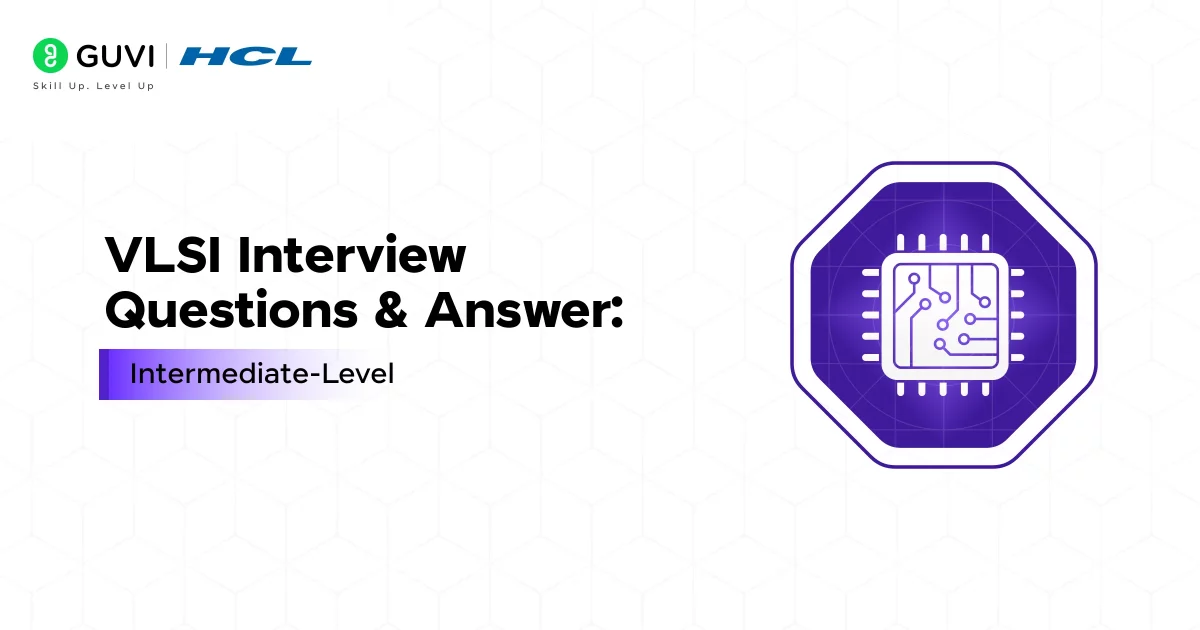
This section is exclusively for those who are already familiar with VLSI design and are working as freshers who want to step up their game. A set of 10 intermediate-level VLSI interview questions and answers to upskill yourself!
11. What is metastability in flip-flops, and how do you prevent it?
Metastability occurs when a flip-flop receives an input change too close to the clock edge, causing an unpredictable output state.
Ways to Prevent Metastability:
- Use Two-Stage Synchronizers: Reduces the chances of metastability affecting circuit operation.
- Increase Setup and Hold Time Margins: Ensures stable input transitions.
- Use Higher Clock Frequencies: Reduces the probability of metastability occurrence.
12. Explain the difference between SRAM and DRAM.
| Feature | SRAM (Static RAM) | DRAM (Dynamic RAM) |
| Storage Mechanism | Uses flip-flops | Uses capacitors |
| Speed | Faster | Slower |
| Power Consumption | Higher | Lower |
| Refreshing | No refresh needed | Needs periodic refreshing |
| Used In | Caches, Registers | Main Memory |
13. What is the role of the FinFET transistor in modern VLSI?
FinFET (Fin Field-Effect Transistor) is a 3D transistor used in sub-20nm technology nodes to improve power efficiency and reduce leakage current.
Advantages of FinFET:
- Better control over short-channel effects.
- Reduced leakage current due to the multi-gate structure.
- Improved performance and power efficiency, making it ideal for modern processors.
14. What are setup and hold time violations?
- Setup Time Violation: Occurs when data does not arrive before the clock edge, leading to incorrect data capture.
- Hold Time Violation: Happens when data changes too soon after the clock edge, causing incorrect latch operation.
Fixes for Setup/Hold Violations:
- Optimize clock skew using better clock distribution techniques.
- Use pipeline registers to balance data propagation delays.
- Modify cell sizing and buffer insertion in critical paths.
15. What is Design for Testability (DFT), and why is it important?
DFT is a methodology used to improve the testability of VLSI circuits. It includes:
- Scan Chains: Allows testing of internal flip-flops via serial shifting.
- Built-In Self-Test (BIST): Embeds self-testing capabilities in the chip.
- Boundary Scan (JTAG): Enables external testing of chip interconnects.
DFT reduces testing complexity and cost, ensuring fault-free chips.
16. What is the difference between full-custom and semi-custom ASIC design?
- Full-Custom ASIC:
- Every transistor is manually placed and optimized.
- Provides maximum performance but is expensive and time-consuming.
- Semi-Custom ASIC:
- Uses pre-designed standard cells and IP blocks.
- Faster design cycle with moderate performance optimization.
17. What is hold time fixing, and how is it implemented?
Hold time fixing ensures data remains stable long enough after the clock edge. It can be done by:
- Adding delay buffers in the data path.
- Using low-skew clock trees.
- Adjusting transistor sizing in critical paths.
18. What is IR Drop in VLSI, and how does it impact performance?
IR Drop is the voltage drop that occurs due to resistance in power/ground networks, leading to:
- Lower circuit performance due to reduced supply voltage.
- Timing failures in critical paths.
Mitigation Techniques:
- Using wider metal layers for power rails.
- Placing de-coupling capacitors near high-power areas.
19. What is the difference between STA and PNR in VLSI design?
- STA (Static Timing Analysis): Checks circuit timing constraints (setup/hold violations).
- PNR (Place & Route): Physically places and routes circuit components.
20. Explain the concept of Dynamic Voltage and Frequency Scaling (DVFS).
DVFS is a power-saving technique that dynamically adjusts voltage and frequency based on workload demand. It helps:
- Reduce power consumption in idle states.
- Improve battery life in portable devices.
VLSI Interview Questions and Answers: Advanced-Level
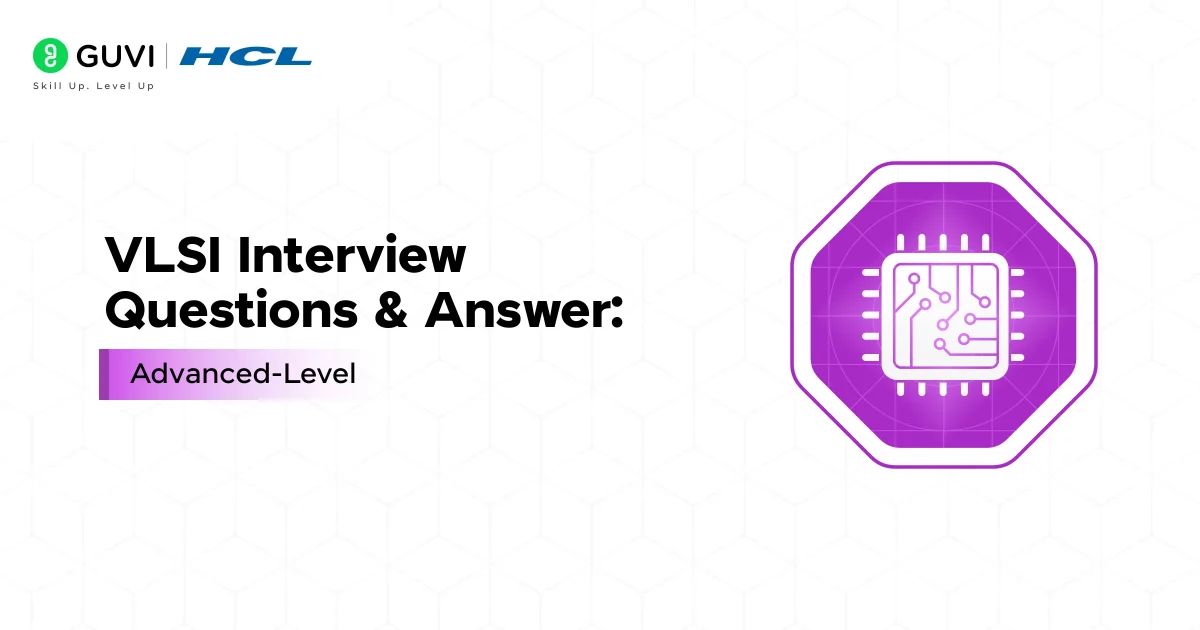
This section is for those who already have enough experience and knowledge to move their career to the next level. Below are 10 advanced-level VLSI interview questions and answers crafted for professionals!
21. What is crosstalk in VLSI, and how is it mitigated?
Crosstalk occurs due to capacitive or inductive coupling between adjacent signal lines, causing unintended noise, glitches, or timing variations.
Mitigation Techniques:
- Increase spacing between signal lines.
- Use shielding wires (ground or VDD).
- Optimize routing and use low-k dielectric materials.
22. What is latch-up in CMOS circuits, and how do you prevent it?
Latch-up is a high-current condition caused by parasitic PNPN structures in CMOS designs, potentially leading to chip failure.
Prevention Methods:
- Guard rings around sensitive regions.
- Deep N-well isolation for NMOS transistors.
- Controlling voltage spikes and using ESD protection circuits.
23. What is the difference between Hard IP and Soft IP in VLSI?
- Hard IP: Pre-implemented, fixed layout, optimized for performance (e.g., PCIe, DDR).
- Soft IP: Provided as RTL (Verilog/VHDL), flexible and customizable (e.g., processors, AXI buses).
24. Explain the concept of On-Chip Variation (OCV).
OCV accounts for process, voltage, and temperature variations affecting transistor behavior. It ensures robust timing closure by considering worst-case scenarios.
Handling OCV:
- Multi-corner static timing analysis (STA).
- Clock and data path balancing.
- Multi-Vt cell optimization.
25. How is power-aware testing performed in VLSI?
Power-aware testing prevents excessive power consumption during chip testing, avoiding failures.
Techniques:
- Clock gating to reduce switching power.
- Low-power scan patterns.
- Segmented scan chains to limit power surges.
26. What are multiple clock domain (MCD) designs, and what challenges do they present?
MCD designs use multiple asynchronous clock signals in SoCs.
Challenges:
- Clock Domain Crossing (CDC) issues → Causes metastability.
- Timing synchronization → Requires dual flip-flops or FIFOs.
- Clock skew handling → Needs robust clock distribution.
27. What is Electromigration (EM) in VLSI interconnects?
Electromigration is metal degradation due to high current density, leading to open/short circuits over time.
Prevention Methods:
- Wider interconnects to reduce current density.
- Adding redundant vias.
- Electromigration-aware signoff analysis.
28. What are the challenges in designing sub-7nm VLSI nodes?
At sub-7nm nodes, quantum effects and scaling limitations pose design challenges.
Key Issues:
- Increased leakage currents.
- Short-channel effects in transistors.
- Complex EUV (Extreme Ultraviolet) lithography requirements.
29. Explain Dynamic IR Drop and how it affects chip performance.
Dynamic IR Drop occurs when high switching activity causes temporary voltage drops, impacting circuit reliability.
Mitigation Strategies:
- Decoupling capacitors to stabilize voltage.
- Stronger power grids to reduce resistance.
- Clock frequency scaling in test modes.
30. What is Dark Silicon and its implications in VLSI?
Dark Silicon refers to inactive regions of a chip that must be powered down to prevent excessive heat and power consumption.
Solutions:
- Power gating to disable unused sections.
- Dynamic Voltage and Frequency Scaling (DVFS) to optimize power.
This completes a comprehensive set of 30 VLSI interview questions and answers, covering practical challenges, coding, and optimization techniques for chip design engineers.
If you want to learn VLSI design through a step-by-step process guided by a professional mentor that includes Digital Electronics, UNIX, and even Shell Scripting, consider enrolling in GUVI’s Certified VLSI Design Course, which not only teaches you everything about the subject but also provides you with an industry-grade certificate!
Conclusion
In conclusion, preparing for VLSI interview questions and answers requires a strong grasp of fundamental concepts, coding skills, and real-world design challenges.
By mastering these questions, you will enhance your technical confidence, improve your circuit design and debugging skills, and be well-prepared for your next VLSI interview. Whether you are applying for an ASIC design role, FPGA development, or physical design engineering, these questions will help you demonstrate competence, problem-solving abilities, and technical expertise in front of recruiters.
Keep practicing, stay updated with the latest advancements in VLSI technology, and approach your interview with confidence. Good luck with your VLSI career journey!





















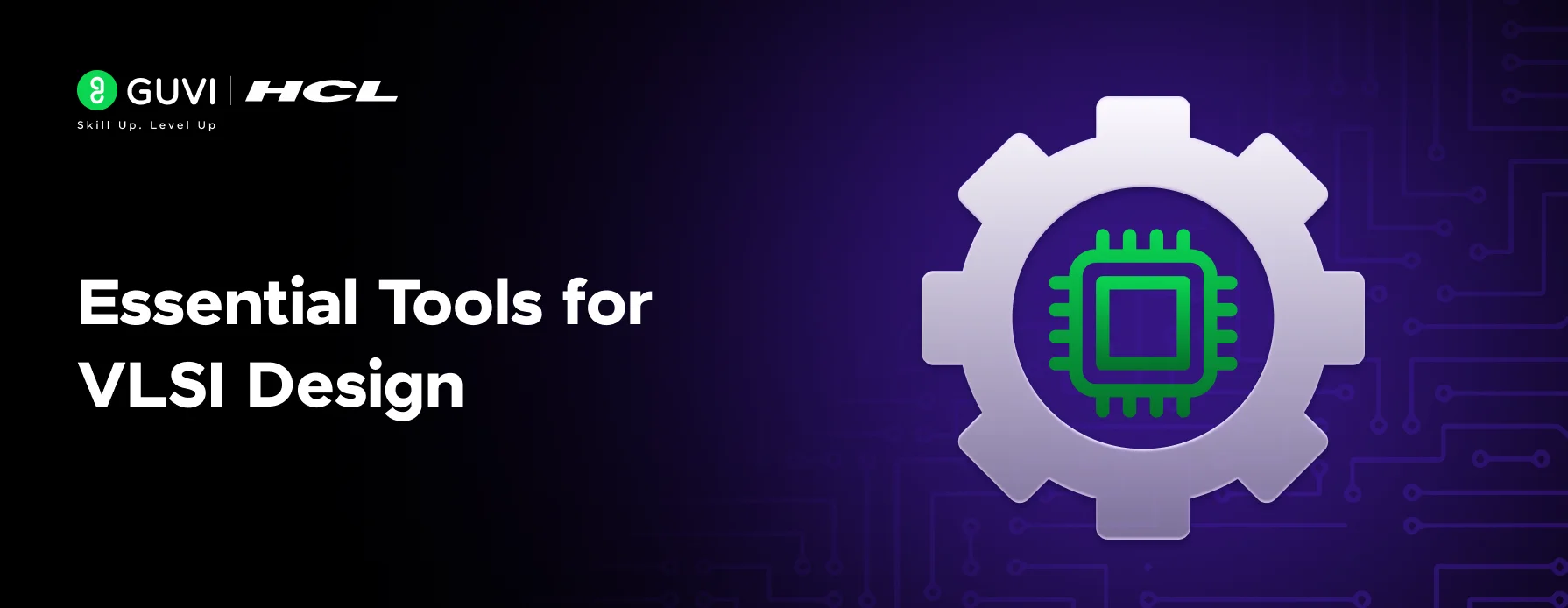
![Top 8 VLSI Design Job Roles [2025] 6 vlsi design job roles](https://www.guvi.in/blog/wp-content/uploads/2025/03/Top-8-VLSI-Design-Job-Roles.png)
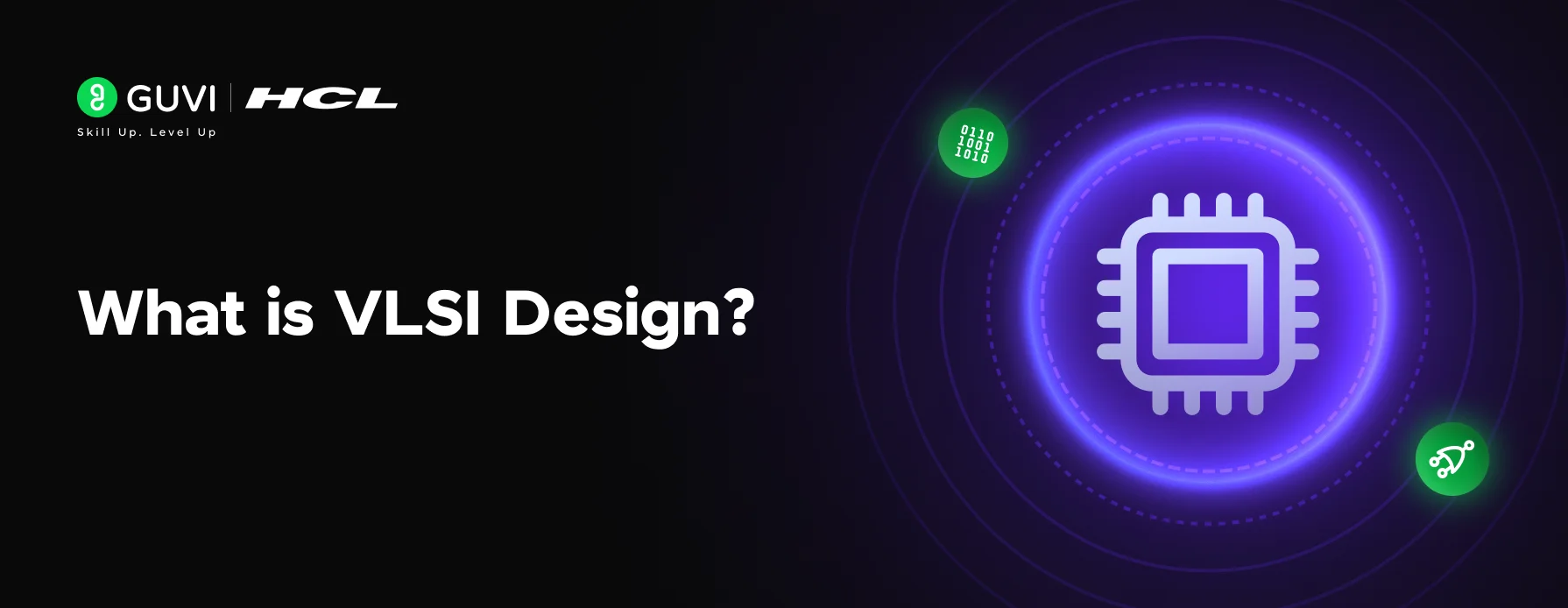
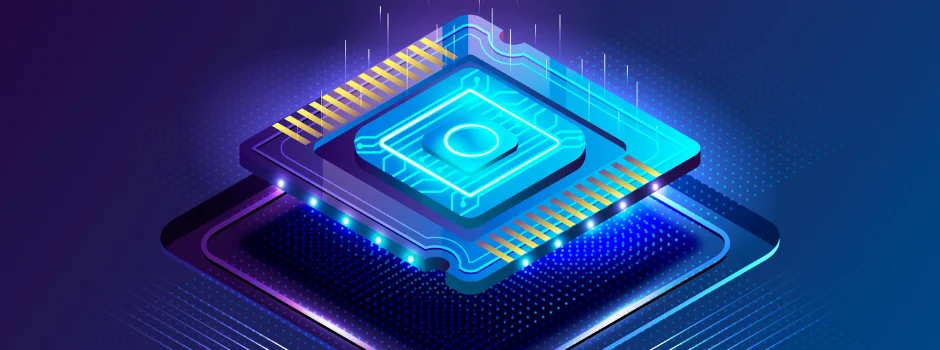

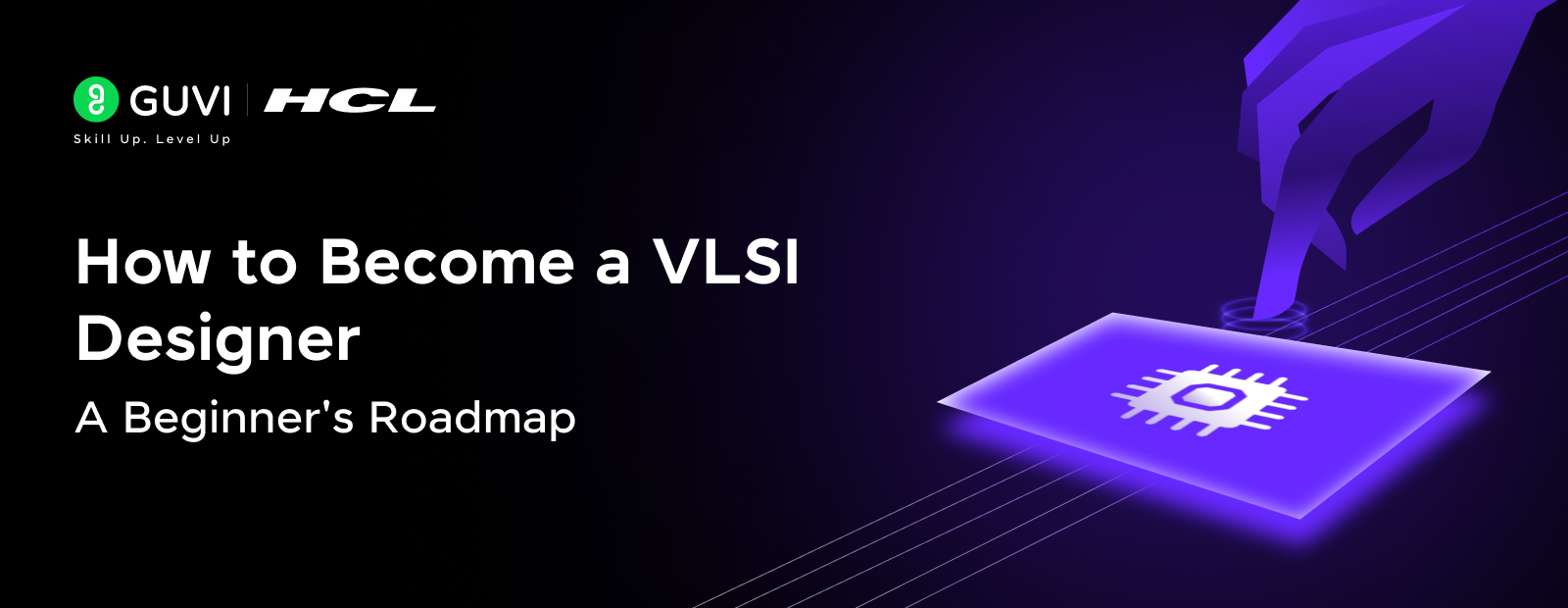
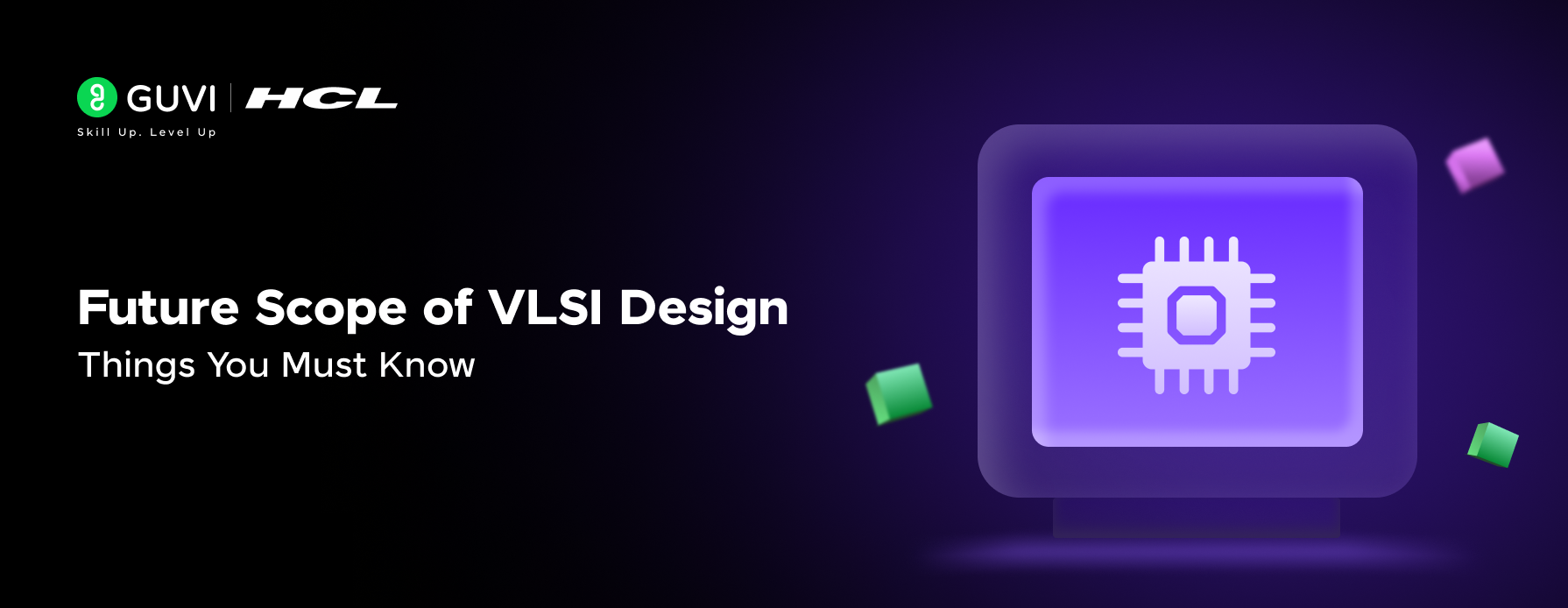



Did you enjoy this article?